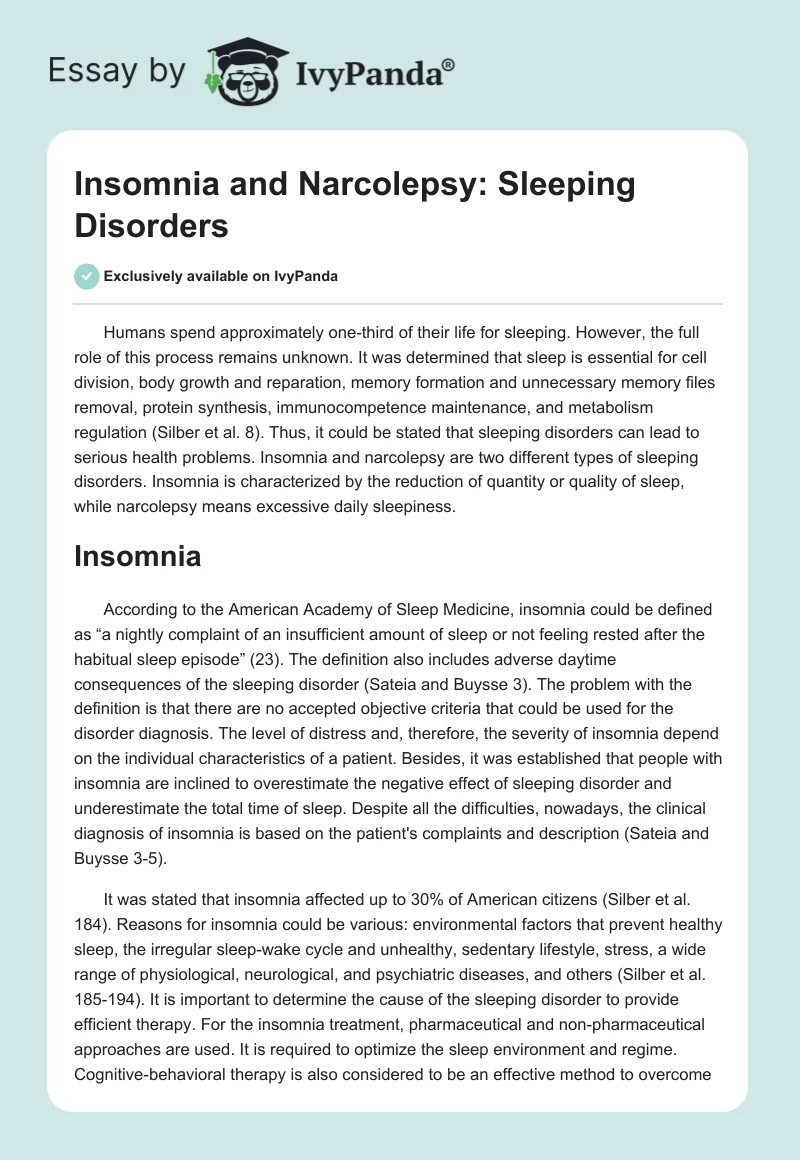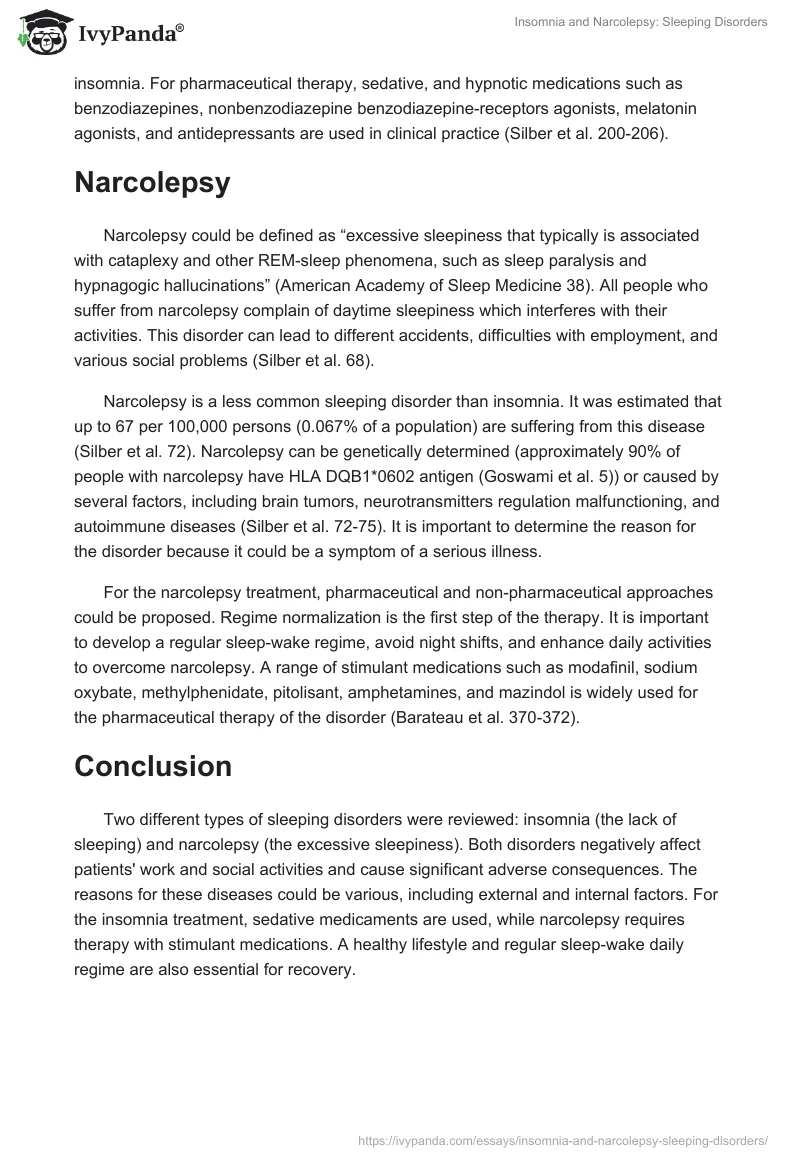Humans spend approximately one-third of their life for sleeping. However, the full role of this process remains unknown. It was determined that sleep is essential for cell division, body growth and reparation, memory formation and unnecessary memory files removal, protein synthesis, immunocompetence maintenance, and metabolism regulation (Silber et al. 8). Thus, it could be stated that sleeping disorders can lead to serious health problems. Insomnia and narcolepsy are two different types of sleeping disorders. Insomnia is characterized by the reduction of quantity or quality of sleep, while narcolepsy means excessive daily sleepiness.
Insomnia
According to the American Academy of Sleep Medicine, insomnia could be defined as “a nightly complaint of an insufficient amount of sleep or not feeling rested after the habitual sleep episode” (23). The definition also includes adverse daytime consequences of the sleeping disorder (Sateia and Buysse 3). The problem with the definition is that there are no accepted objective criteria that could be used for the disorder diagnosis. The level of distress and, therefore, the severity of insomnia depend on the individual characteristics of a patient. Besides, it was established that people with insomnia are inclined to overestimate the negative effect of sleeping disorder and underestimate the total time of sleep. Despite all the difficulties, nowadays, the clinical diagnosis of insomnia is based on the patient’s complaints and description (Sateia and Buysse 3-5).
It was stated that insomnia affected up to 30% of American citizens (Silber et al. 184). Reasons for insomnia could be various: environmental factors that prevent healthy sleep, the irregular sleep-wake cycle and unhealthy, sedentary lifestyle, stress, a wide range of physiological, neurological, and psychiatric diseases, and others (Silber et al. 185-194). It is important to determine the cause of the sleeping disorder to provide efficient therapy. For the insomnia treatment, pharmaceutical and non-pharmaceutical approaches are used. It is required to optimize the sleep environment and regime. Cognitive-behavioral therapy is also considered to be an effective method to overcome insomnia. For pharmaceutical therapy, sedative, and hypnotic medications such as benzodiazepines, nonbenzodiazepine benzodiazepine-receptors agonists, melatonin agonists, and antidepressants are used in clinical practice (Silber et al. 200-206).
Narcolepsy
Narcolepsy could be defined as “excessive sleepiness that typically is associated with cataplexy and other REM-sleep phenomena, such as sleep paralysis and hypnagogic hallucinations” (American Academy of Sleep Medicine 38). All people who suffer from narcolepsy complain of daytime sleepiness which interferes with their activities. This disorder can lead to different accidents, difficulties with employment, and various social problems (Silber et al. 68).
Narcolepsy is a less common sleeping disorder than insomnia. It was estimated that up to 67 per 100,000 persons (0.067% of a population) are suffering from this disease (Silber et al. 72). Narcolepsy can be genetically determined (approximately 90% of people with narcolepsy have HLA DQB1*0602 antigen (Goswami et al. 5)) or caused by several factors, including brain tumors, neurotransmitters regulation malfunctioning, and autoimmune diseases (Silber et al. 72-75). It is important to determine the reason for the disorder because it could be a symptom of a serious illness.
For the narcolepsy treatment, pharmaceutical and non-pharmaceutical approaches could be proposed. Regime normalization is the first step of the therapy. It is important to develop a regular sleep-wake regime, avoid night shifts, and enhance daily activities to overcome narcolepsy. A range of stimulant medications such as modafinil, sodium oxybate, methylphenidate, pitolisant, amphetamines, and mazindol is widely used for the pharmaceutical therapy of the disorder (Barateau et al. 370-372).
Conclusion
Two different types of sleeping disorders were reviewed: insomnia (the lack of sleeping) and narcolepsy (the excessive sleepiness). Both disorders negatively affect patients’ work and social activities and cause significant adverse consequences. The reasons for these diseases could be various, including external and internal factors. For the insomnia treatment, sedative medicaments are used, while narcolepsy requires therapy with stimulant medications. A healthy lifestyle and regular sleep-wake daily regime are also essential for recovery.
Works Cited
American Academy of Sleep Medicine. The International Classification of Sleep Disorders: Diagnostic and Coding Manual. 2nd ed., American Academy of Sleep Medicine, 2005.
Barateau, Lucie, et al. “Treatment Options for Narcolepsy.” CNS Drugs vol. 30, no. 5, 2016, pp. 369-379. Web.
Goswami, Meeta, et al., editors. Narcolepsy: A Clinical Guide. 2nd ed., Springer, 2016.
Sateia, Michael J., and Daniel Buysse, editors. Insomnia: Diagnosis and Treatment. 2nd ed., CRC Press, 2016.
Silber, Michael H., et al. Sleep Medicine in Clinical Practice. 2nd ed., CRC Press, 2016.


